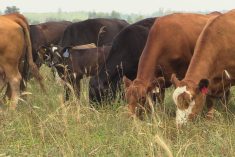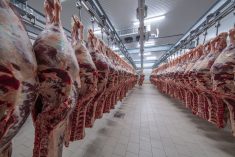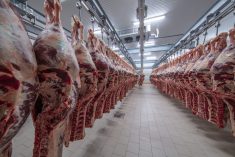Canada’s beef cattle producer groups and federal Conservatives want to see the revival of a BSE-era program to hold cattle back against the risk of further lost options for slaughter.
The Canadian Cattlemen’s Association on Monday hearkened back to its March 24 list of recommendations to the federal government for support measures against the impacts of the COVID-19 coronavirus pandemic.
Last on that list was to rebuild the “infrastructure and governance” for a fed cattle set-aside program, in case of “a potential major beef supply chain disruption across Canada.”
Read Also

U.S. grains: CBOT soybeans, corn, wheat fall in USDA data aftermath
Chicago grains took a dive on Friday, following a closely watched U.S. government crop report and the release of export data that could provide clues into Chinese buying.
The beef sector is now headed the right way to such a disruption, the CCA said Monday, noting the temporary halt, also announced Monday, of the second shift at Cargill’s High River, Alta. beef packing plant.
The High River plant alone represents about 36 per cent of Canada’s total beef processing capacity, the CCA said, also noting other packers are now “marginally” reducing capacity to allow for COVID-19 protocols, such as spacing of workers.
Noting it’s already in talks with federal officials about its recommendations, the CCA said Monday it “recognizes that we are now in a critical situation and recommends (a set-aside) program be reinstated and implemented immediately.”
A set-aside is meant to delay the marketing of cattle when processing capacity isn’t available, by encouraging producers to hold cattle on maintenance rations, the CCA said.
Cattle marketings could thus be stretched out over a longer period and managed by existing packing capacity, “until slaughter capacity can be regained,” the association said.
As described in its March 24 document, the CCA’s proposed fed cattle set-aside would see feedlot producers bid to extend the feeding period of cattle up to a maximum of $2 per head per day for up to 90 days.
The program design would be similar to the 2004 model set up during Canada’s BSE crisis, the CCA said; that model included a governing committee of independent experts, calls for bids from cattle feeders, and holdbacks of enrolled animals.
Similar, that is, except that the CCA also now proposes the set-aside plan be made permanent.
A new set-aside program, the CCA said, “would remain in place as a possible mechanism to address seasonal surpluses in Ontario, and in the event of any major disruption to the beef supply chain across Canada.”
‘Certainty’
Representatives of the beef cattle producer associations in Ontario, Quebec, New Brunswick, Nova Scotia and Prince Edward Island already called separately for a set-aside, among other recommendations, in a joint letter to federal Agriculture Minister Marie-Claude Bibeau on April 8.
A feeder/fed cattle set-aside, they said, “will help spread out the supply of cattle in a co-ordinated fashion, which would allow processors to clean up the existing supply of market-ready cattle, and delay the marketing of other animals in the system.”
“We learned many lessons during the hard years of BSE, and it is time to implement the policies that previously helped us weather the storm,” CCA president Bob Lowe said in the national association’s release Monday.
In a separate letter Wednesday, the federal Conservatives’ agriculture critic John Barlow, deputy ag critic Lianne Rood and associate ag critic Richard Lehoux called on Bibeau to “immediately implement a temporary cattle set-aside program to deal with the meat processing capacity crisis that Canada is currently facing.”
Canada, they wrote, “was already facing a meat processing crisis. This has only gotten worse during the COVID-19 pandemic, as plants have closed or reduced shifts…Your government’s plan to deal with this issue and many others needs to be clear and transparent in order to provide certainty to the agriculture sector.” — Glacier FarmMedia Network














